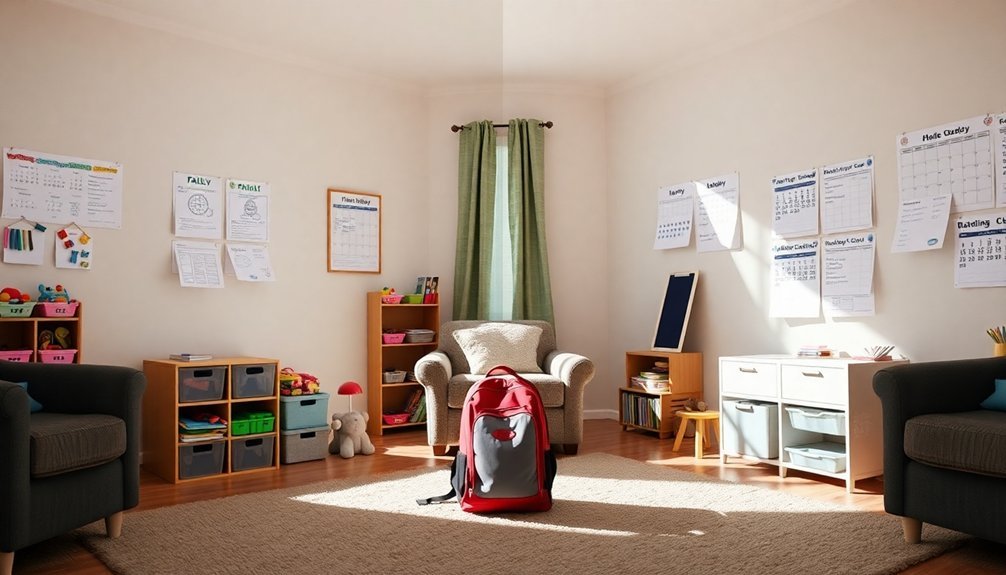While 50/50 parenting can feel like an emotional tightrope walk, it's actually one of the most beneficial arrangements for children when done right. You'll find that successful co-parenting isn't about perfection, but rather about creating a sustainable system that works for everyone involved. Through clear communication, consistent rules, and thoughtful planning, you can transform what might seem like an overwhelming challenge into a manageable routine. Whether you're just starting your co-parenting journey or looking to improve your current arrangement, understanding the key principles of shared custody will help you create a more harmonious experience for both homes.
Key Takeaways
- Create a consistent custody schedule with digital calendars and co-parenting apps to track transitions, appointments, and activities effectively.
- Establish aligned household rules and routines across both homes to provide stability and predictability for children.
- Maintain business-like communication focused solely on children's needs, using structured channels and respecting response timeframes.
- Plan transitions carefully with packed essentials, neutral handoff locations, and emotional support for children during changeovers.
- Address conflicts promptly through mediation or structured negotiation, documenting agreements and maintaining flexibility when needed.
Understanding 50/50 Custody Schedules
Shared custody arrangements in which each parent has equal time with their children require careful planning and structure. When you're managing 50/50 parenting, understanding various custody schedules helps you choose the best fit for your family's needs.
Common custody arrangements include alternating weeks, 2-2-3 rotations (two days with one parent, two with the other, then three days alternating), and 3-4-4-3 schedules. Each pattern offers different advantages, and you'll need to evaluate factors like your work schedule, the children's school locations, and extracurricular activities.
Schedule flexibility is essential for success in 50/50 parenting. You'll want to build in provisions for holidays, special events, and unexpected situations.
Think about creating a shared calendar system where both parents can access and update information about appointments, school events, and activities.
Remember that shifts between homes should align with your children's routines. If possible, arrange exchanges that don't disrupt school or sleep schedules.
As your children grow, you may need to adjust your arrangement to accommodate their changing needs, so maintain open communication with your co-parent about schedule modifications.
Communication Between Co-Parents

Effective communication forms the backbone of successful 50/50 parenting arrangements. You'll need to establish clear channels and effective strategies for sharing information about your children's daily lives, schedules, and well-being. Regular, respectful communication helps guarantee both parents stay informed and involved in important decisions.
To maintain open dialogue, you can utilize various tools and methods. Set up a shared digital calendar for scheduling, use co-parenting apps for messaging, and keep a shared document for important information about school, medical appointments, and activities.
You'll want to establish ground rules for communication, including response times and preferred contact methods. Remember to keep your communications focused on the children and maintain a business-like tone. Share important updates promptly, document significant conversations, and avoid discussing personal matters unrelated to parenting.
When disagreements arise, address them professionally and consider using a mediator if needed. By staying committed to clear, consistent communication, you're creating a stable environment for your children while demonstrating healthy conflict resolution.
This approach helps both parents maintain their important roles in their children's lives while fostering a cooperative co-parenting relationship.
Creating Consistent Household Rules

Establishing three core sets of rules – safety, behavior, and routines – across both households creates stability for children in 50/50 custody arrangements.
When you and your co-parent align on household expectations, you're providing your children with a predictable environment that supports their emotional well-being.
Start by identifying non-negotiable safety rules that must remain consistent, such as supervision requirements, internet usage guidelines, and emergency protocols.
Next, establish aligned behavioral expectations, including respect for authority, homework completion, and consequences for rule violations.
Finally, create parallel daily routines for bedtime, meals, and chores that work in both homes.
You'll strengthen rule consistency by documenting agreed-upon guidelines in writing and sharing them between households.
Hold regular check-ins with your co-parent to discuss what's working and what needs adjustment.
Remember that while minor variations between homes are normal, maintaining similar core rules helps children adapt smoothly between parents.
If disagreements arise about specific rules, focus on your shared goal of providing stability.
Consider engaging a family mediator to help establish mutually acceptable household expectations when needed.
Managing Child Transitions Effectively

Moving between two households requires careful planning and emotional support for children in 50/50 custody arrangements. You'll need to establish shifting strategies that minimize stress and create a sense of stability for your child during these regular changes between homes.
Keep change days consistent and predictable by using a shared calendar system. Pack necessary items the night before and create detailed checklists to guarantee nothing gets left behind. You'll want to maintain a duplicate set of essential items at both homes to reduce packing stress and forgotten items.
Your child's emotional support during changes is vital. Schedule handoffs at neutral locations, maintain a positive attitude, and avoid discussing co-parenting conflicts during these exchanges.
Create special arrival rituals at each home, such as unpacking together or sharing a meal, to help your child adjust.
Give your child time to decompress after changes. Don't schedule demanding activities immediately after the switch, and maintain open communication about their feelings.
Remember that successful changes often depend on both parents working together to create a seamless experience that prioritizes their child's emotional well-being.
Resolving Conflicts and Disagreements

Sooner or later, disagreements will arise in your 50/50 parenting arrangement. When conflicts emerge, it's essential to handle them through effective negotiation and structured conflict resolution approaches that protect your children's well-being.
| Conflict Type | Impact on Children | Resolution Strategy |
|---|---|---|
| Schedule Changes | Anxiety & Stress | Use digital calendar, plan ahead |
| Financial Disputes | Security Concerns | Document agreements, mediate early |
| Parenting Style | Behavioral Issues | Find common ground, be consistent |
| New Partners | Emotional Confusion | Introduce gradually, maintain boundaries |
| Communication | Trust Issues | Use co-parenting apps, stay neutral |
Remember that successful conflict resolution requires both parents to remain focused on their children's needs rather than personal grievances. When you're stuck, don't hesitate to seek professional mediation – it's often more effective than prolonged disagreements.
Set clear boundaries for discussions, stick to facts rather than emotions, and always communicate in writing when dealing with significant issues. You'll find that most conflicts can be resolved through a combination of clear documentation, respectful dialogue, and a willingness to compromise. If you're struggling to reach an agreement, consider involving a family counselor who specializes in co-parenting dynamics.
Frequently Asked Questions
How Do Tax Deductions Work in a 50/50 Custody Arrangement?
In a 50/50 custody arrangement, you'll need to decide which parent claims the child on their taxes.
You can't both claim tax credits for the same child. Typically, you'll either alternate years or assign specific children to each parent.
Your filing status as "head of household" may be available if you provide more than half of your child's household expenses, even with equal custody.
Always document your agreement in writing to avoid tax disputes.
Can a Parent Relocate to Another State With 50/50 Custody?
You can't unilaterally relocate to another state with 50/50 custody without court approval and your co-parent's consent.
You'll need to petition the court for custody modifications, as moving would greatly impact the existing arrangement.
Relocation considerations include the child's relationship with both parents, educational opportunities, and maintaining meaningful contact.
Courts prioritize the child's best interests, so you'll need compelling reasons to justify disrupting the current 50/50 schedule.
What Happens to Child Support Payments in a True 50/50 Arrangement?
Picture two trees sharing equal sunlight and water – that's how 50/50 custody works.
In a true 50/50 arrangement, you'll find that child support payments often differ from traditional custody scenarios. Your state's guidelines will determine if payments are necessary, typically considering both parents' incomes and expenses.
Even with equal time, if there's an income disparity, you may still need to pay or receive support to guarantee your child's consistent standard of living across both homes.
How Do Parents Split Expenses for Extracurricular Activities and School Supplies?
You'll need clear activity budgeting and supply sharing agreements with your co-parent.
It's best to split major expenses like sports equipment, music lessons, or school supplies equally, but you can also divide based on income ratios.
Keep receipts and use a shared spreadsheet or co-parenting app to track expenses.
You'll want to decide upfront who pays for what and establish a reimbursement schedule.
Many parents create a joint fund specifically for these shared costs.
When Does 50/50 Custody Typically End if a Child Goes to College?
Just like a bird leaving its nest, your child's shift to college marks a natural evolution in custody arrangements.
While most custody agreements legally end when your child turns 18 or graduates high school, college living introduces new dynamics.
You'll need to contemplate how holidays, breaks, and summer schedules work with both parents.
Many families find that their formal 50/50 arrangement naturally shifts to a more flexible schedule based on your child's college calendar and preferences.
Conclusion
Success in 50/50 parenting depends on your commitment to clear communication, consistent rules, and cooperative scheduling. You'll find that digital tools streamline your co-parenting journey, while established routines create stability for your children. When you prioritize your children's well-being, maintain respectful boundaries, and embrace flexibility, you're building a foundation for positive shared custody experiences. Your dedication to effective co-parenting will shape your children's future relationships and emotional health.








0 responses to “The Ultimate Guide to 50/50 Parenting: Making It Work For Everyone”
Interesting read, but wouldnt a 70/30 split be more beneficial for kids stability rather than an equal 50/50 split? Just food for thought.
Interesting read! But does 50/50 parenting truly work in all scenarios? What about families living far apart or with conflicting work schedules?
50/50 parenting isnt a one-size-fits-all solution. Every familys dynamics are unique and challenging!
Id argue that the success of 50/50 parenting hugely depends on the kids adaptability. Not every child can handle two homes. Thoughts?
While this guide is comprehensive, is 50/50 parenting really feasible in cases where parents live in different cities? #foodforthought
50/50 parenting is possible if parents prioritize children over their location. #unpopularopinion
This 50/50 parenting guide is great, but dont you think it assumes too much idealism? Co-parenting communication isnt always smooth.